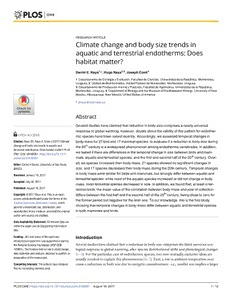
Climate change and body size trends in aquatic and terrestrial endotherms: Does habitat matter? PDF
Preview Climate change and body size trends in aquatic and terrestrial endotherms: Does habitat matter?
RESEARCHARTICLE Climate change and body size trends in aquatic and terrestrial endotherms: Does habitat matter? DanielE.Naya1*,HugoNaya2,3,JosephCook4 1 DepartamentodeEcolog´ıayEvolucio´n,FacultaddeCiencias,UniversidaddelaRepu´blica,Montevideo, Uruguay,2 UnidaddeBioinforma´tica,InstitutPasteurdeMontevideo,Montevideo,Uruguay, 3 DepartamentodeProduccio´nAnimalyPasturas,FacultaddeAgronom´ıa,UniversidaddelaRepu´blica, Montevideo,Uruguay,4 DepartmentofBiologyandtheMuseumofSouthwesternBiology,UniversityofNew a1111111111 Mexico,Albuquerque,NewMexico,UnitedStatesofAmerica a1111111111 *[email protected] a1111111111 a1111111111 a1111111111 Abstract Severalstudieshaveclaimedthatreductioninbodysizecomprisesanearlyuniversal responsetoglobalwarming;however,doubtsaboutthevalidityofthispatternforendother- OPENACCESS micspecieshavebeenraisedrecently.Accordingly,weassessedtemporalchangesin Citation:NayaDE,NayaH,CookJ(2017)Climate bodymassfor27birdand17mammalspecies,toevaluateifareductioninbodysizeduring changeandbodysizetrendsinaquaticand the20thcenturyisawidespreadphenomenonamongendothermicvertebrates.Inaddition, terrestrialendotherms:Doeshabitatmatter?PLoS wetestediftherearedifferencesinthetemporalchangeinsizebetweenbirdsandmam- ONE12(8):e0183051.https://doi.org/10.1371/ journal.pone.0183051 mals,aquaticandterrestrialspecies,andthefirstandsecondhalfofthe20thcentury.Over- all,sixspeciesincreasedtheirbodymass,21speciesshowednosignificantchangesin Editor:CarlosANavas,UniversityofSaoPaulo, BRAZIL size,and17speciesdecreasedtheirbodymassduringthe20thcentury.Temporalchanges inbodymassweresimilarforbirdsandmammals,butstronglydifferbetweenaquaticand Received:January19,2017 terrestrialspecies:whilemostoftheaquaticspeciesincreasedordidnotchangeinbody Accepted:July30,2017 mass,mostterrestrialspeciesdecreasedinsize.Inaddition,wefoundthat,atleastinter- Published:August16,2017 restrialbirds,themeanvalueofthecorrelationbetweenbodymassandyearofcollection Copyright:©2017Nayaetal.Thisisanopen differsbetweenthefirsthalfandthesecondhalfofthe20thcentury,beingclosetozerofor accessarticledistributedunderthetermsofthe theformerperiodbutnegativeforthelaterone.Toourknowledge,thisisthefirststudy CreativeCommonsAttributionLicense,which showingthattemporalchangesinbodymassdifferbetweenaquaticandterrestrialspecies permitsunrestricteduse,distribution,and reproductioninanymedium,providedtheoriginal inbothmammalsandbirds. authorandsourcearecredited. DataAvailabilityStatement:Allrelevantdataare withinthepaperanditsSupportingInformation files. Funding:JACandsomeofthespecimen Introduction infrastructureusedherewassupportedinpartby Severalstudieshaveclaimedthatareductioninbodysizecomprisesthethirduniversaleco- theNationalScienceFoundation(NSF-DEB 125801).Thefundershadnoroleinstudydesign, logicalresponsetoglobalwarming,afterspeciesdistributionalshiftsandphenologicalchanges datacollectionandanalysis,decisiontopublish,or [1–3].Fortheparticularcaseofendothermicspecies,twonon-mutuallyexclusiveideasare preparationofthemanuscript. usuallyinvokedtoexplainthisphenomenon[4–7].First,ariseinambienttemperaturemay Competinginterests:Theauthorshavedeclared causeareductioninbodysizeduetoenergeticconsiderations–i.e.,smallersizeimpliesalarger thatnocompetinginterestsexist. PLOSONE|https://doi.org/10.1371/journal.pone.0183051 August16,2017 1/12 Climatechangeandbodysizetrendsinendotherms surfacetovolumeratioandis“better”forheatdissipationinwarmerclimates–inlinewith KarlBergmann’sfamousargument[8].Second,adecreaseinresourceavailability(orquality) couldcauseareductionintherateofgrowththroughoutananimal’sdevelopment,resulting inasmalleradultsize.Asforthemechanisticbasisofthesechanges,twonon-mutuallyexclu- siveexplanationsareusuallyadvanced:aplasticresponseattheindividuallevel[9–10]and geneticchangesatthepopulationlevel[11–12].Eventhoughveryfewstudieshaveevaluated therelativeweightofthesetwomechanisms,currentevidencesuggeststhatphenotypicplastic- ityusuallyaccountsforahigherportion,ifnotforall,oftheoverallphenotypicchange[13– 14]. However,leavingasidethepotentialcausesandthemechanisticbasisfortheobserved changes,doubtshavebeenraisedrecentlyaboutthevalidityofarelationshipbetween temperatureandbody-sizeinendothermicspecies[5,15–18].Inlinewiththis,oursemi- quantitativereviewofcurrentevidenceontemporalchangeinbodysizeforendothermic vertebratessuggeststhatnoclearpatternisevident.Specifically,afteranalyzingdatafrom 46studies,comprisingatotalof369populationsofbirdsandmammals(S1Dataset),we concludethat:(i)regardlessofthestatisticalsignificanceofthechanges,theproportionof populationsthatincreasetheirsizeissimilartotheproportionofpopulationsthatdecrease theirsize(Fig1a),and(ii)whenthestatisticalsignificanceofthechangesistakeninto account,nearlytwo-thirdsofpopulationsanalyzedtodateshowednosignificanttemporal changesinbodysize(Fig1b).Inaddition,twointriguingpointsemergefromthissemi- quantitativeassessment.First,withacoupleofexceptions,allthestudiesanalyzingonlya singlepopulationreportedsignificanttemporalchangeinsize,whileallthestudiesanalyz- ingmorethanonepopulation(orspecies)indicatethatnosignificantchangesarecommon. Suchdifferencesclearlysuggestapublicationbiasthatcouldaffectimpressionsaboutthe ubiquityoftemporalchangesinbodysize(see[15]).Second,withveryfewexceptions, studiesanalyzingmorethanonepopulationofthesamespecies,orthecombinationofdif- ferentstudiesevaluatingdifferentpopulationsofthesamespecies,indicatethatobserved responsesusuallyvary,inboththesignofthetrendandstatisticalsignificance,fromone populationtotheother.Thatis,thereissignificantvariationinbodysizechangesfromsite tosite,whichsuggestthatidiosyncraticresponses,probablylinkedtodifferencesinlocal conditions[19]oreventodispersaleventsbetweenlocalities[20],arecommon.Insum- mary,itisclearthatweneedtoevaluatemuchmoredatabeforeacceptingthatareduction inbodymassassociatedwithglobalwarmingor,moregenerally,withglobalenvironmental change,comprisesageneralruleforendotherms.Inparticular,weneedtoconductmore multi-speciescomparativestudies,tounderstandthenaturalvariationinphenotypic responses,andusesimilarmethods(e.g.,thesamemeasurementofbodysize)acrosslarge geographicareas,toreducetheincidenceofconfoundingfactorsandtoaccountforpoten- tialsite-to-sitefluctuations. Withinthiscontext,weassessedtemporalchangeinbodymassfor27birdand17mammal speciestoevaluateifareductioninbodysizeduringthe20thcentury,whateveritscausesand mechanisticbasis,isawidespreadphenomenonamongendothermicvertebrates.Inaddition, wetestedwhethertherearedifferencesinthetemporalresponsebetween:(1)birdsandmam- mals,(2)aquaticandterrestrialspecies,and(3)thefirstandsecondhalfofthe20thcentury.To thebestofourknowledge,thisisthefirststudythat:(i)simultaneouslyassessestemporal changesinbodysizeforbirdsandmammals,usingthesamemethodologytoanalyzebothtax- onomicgroupsandaccountingfortheeffectofphylogeny,and(ii)evaluatesdifferencesinthe temporalresponsesbetweenaquaticandterrestrialspecies. PLOSONE|https://doi.org/10.1371/journal.pone.0183051 August16,2017 2/12 Climatechangeandbodysizetrendsinendotherms Fig1.Percentegeofbirdandmammalpopulationsthatshowdifferenttemporalresponsesinbody size,takingintoaccount(a)onlythesignofthechanges(upperpanels),and(b)thestatistical significanceofthechanges(lowerpanels).Datawereanalyzedseparatelyfortrendandsignificance becausestatisticalsignificancedependsonsamplesize(whichvariesfromcasetocase),andalsobecause somestudiesonlyreportthesignofthetemporaltrend,whileotherstudiesonlyreportthatchangeswerenot significant(seeS1Datasetfordetails). https://doi.org/10.1371/journal.pone.0183051.g001 Methods Databasedescription Toassesstemporalchangeinbodysize,wedownloadeddataonbodymassforendothermic vertebrates,withtheexceptionofrodentsandpasserinebirdsduetologisticconstraints(i.e., ourinabilitytocuratetwodatasetswithseveralthousandsofrecords)fromArctos,anonline naturalhistorydatabase(www.arctos.database.museum).Weincludedallspecieswithmore than100geo-referencedrecordsofsexedindividuals,coveringthelastfourdecadesatleast. Weexcludedsixspeciesforwhichmostofthedata(>80%)span<10yearsofcollection (FigureAinS1Appendix),andremoved26outlierrecordscorrespondingtoverysmallindi- viduals,inwhichbodymasswasclosetozero.Thoseselectioncriteriayieldedatotalof 20,496recordsbelongingto44species(S2Dataset).Thesespecieswerethenclassified,based oninformationprovidedbyIUCN(http://www.iucnredlist.org/),BirdlifeInternational (http://www.birdlife.org/),andtheMuseumofZoologyoftheUniversityofMichigan(http:// animaldiversity.org/),asaquatic,iftheyinhabitfreshwaterand/ormarinehabitatsinaddi- tiontoterrestrialones(birds:n=10,mammals:n=4),orterrestrial,iftheyonlyinhabitter- restrialhabitats(birds:n=17,mammals:n=13).Byanalyzingmultiplepopulationsofeach speciesoverbroadgeographicalareas(seeFigureBinS1Appendix),ouranalysisintendedto PLOSONE|https://doi.org/10.1371/journal.pone.0183051 August16,2017 3/12 Climatechangeandbodysizetrendsinendotherms identifyresponsesatthespecieslevel,ratherthanlocalresponsesatthepopulationlevel. Also,ouranalysisassumedthattheeffectsofseveralfactorsthatcouldaffectbodymassand thatwecannotfilterstatistically(e.g.,ageofeachindividual,seasonoftheyear,timeofthe dayofcapture,peopletakingthemeasurements)arerandomlydistributedamongyears. Comparisonbetweentaxonomicgroupsandspecieshabitats Weestimatedthepartialcorrelationcoefficientbetweenbodymassandtheyearofcollection (r )foreachspeciesseparately,throughconventionallinearregressionmodels,using(abso- year lute)latitude,longitude,andsexascovariatesinthemodels.Then,weevaluateddifferencesin r betweentaxonomicgroups(i.e.,birdsormammals)andspecieshabitats(i.e.,aquaticor year terrestrial)usingatwo-wayANOVA.Thecorrelationcoefficientbetweenbodymassandthe yearofcollection(r )wasnotcorrelatedwithsamplesize,speciesbodymass,orspeciesdis- year tribution,butwascorrelatedwiththelengthofthetimeseries(r=0.36,P=0.02).Hence,in additiontotheANOVA,wealsorananANCOVAusingthelengthoftimeseriesasacovari- ate.Intheseanalyses,weusedtheKolmogorov-Smirnovtesttoassessnormality,Levene’stest toassesshomogeneityofvariance,and(inANCOVA)aparallelismtesttoassesstheinterac- tionbetweenfactorsandthecovariate.AlltheseanalysesweredonewithStatistica(version 8.0)software[21],withstatisticalsignificanceestablishedattheα=0.05level. Totakeintoaccountphylogeneticrelationshipsamongspecies,therelationshipbetween bodymassandtheyearofcollectionwasalsoevaluatedusingaphylogeneticgeneralizedlinear mixedmodel(PGLMM)[22],withspeciesasarandomfactor,taxonomicgroupandhabitatas fixedfactors,and(absolute)latitude,longitude,sexandlengthofthetimeseriesascovariates (modelA).Toconsiderpotentialinteractionsbetweentheyearofcollectionandfixedfactors, werantwoadditionalmodels:oneincludingtheinteractiontermwithtaxonomicgroup (modelB)andtheotherincludingtheinteractiontermwithhabitat(modelC).Inallthese models,speciesbodymasswasstandardizedtoameanequaltozeroandvarianceequalto one.Thephylogenetictreeusedintheseanalyses(FigureCinS1Appendix)wasbasedon previouslypublishedpapersforbirds[23]andmammals[24–25].Giventhatbranchlengthis notknownforthistree,wesetalllengthstoone.Phylogeneticanalyseswererunwiththe MCMCglmmpackage[26]inthefreesoftwareR[27].Inferencesforeachregressionmodel werebasedon200,000samples,obtainedafterdiscarding50,000samplesasburnin.Inall models,defaultpriorswereusedfor“fixed”effects,whileinverseWishartpriorswithscale parameterequaltohalfofdependentvariablevariance(and3degreesoffreedom)wereused for“random"effects.Athinningintervalof100wasusedforcomputingfeaturesoftheposte- riordistribution.Convergencediagnostics,statisticalandgraphicalanalysesofMarkovchain MonteCarlo(MCMC)samplingoutputwerecarriedoutwiththeCODApackage[28]avail- ableinR.Finally,thesignificanceofeachregressioncoefficientwasestimatedfromMarkov chainMonteCarlop-value(pMCMC),whichbasicallyrepresents(2x)theproportionofposte- riorvaluesthatareoftheoppositesigntotheparameterestimate,whereasthefitofeach modeltothedatawasassessedthroughDevianceInformationCriterion(DICscores). Temporalvariationinthetemporalresponses Becausedataforterrestrialbirdspeciesarefairlyevenlydistributedintimethroughmostof the20thcentury(seeFigureBinS1Appendix),wedecidedtoevaluatetemporalchangesinthe relationshipbetweenbodymassandyearofcollectionwiththisgroupofspecies.Forthatpur- pose,wesplittheseriesofeachspeciesintotwoperiodsoftime:onefromtheearliestdateof collection(ca.1915)to1950,representingarelativelylowintensityofchangeinenvironmental conditions,andtheotherfrom1951tothelatestdateofcollection(ca.2013),representinga PLOSONE|https://doi.org/10.1371/journal.pone.0183051 August16,2017 4/12 Climatechangeandbodysizetrendsinendotherms relativelyhighintensityofchangeinenvironmentalconditions[29].Notethattheincreasein globallyaveragedtemperatureovertheperiod1901–2012wasabout0.89˚C,whiletheincrease overjusttheperiod1951–2012wasabout0.72˚C[29].Thus,therateofchangeinambient temperatureforoursecondperiod(ca.0.12˚Cperdecade)isalmostfourtimesgreaterthan forourfirstperiodoftime(ca.0.03˚Cperdecade).Foreachspeciesandperiodoftime,wecal- culatedthepartialcorrelationfortheyearofcollection(r )using(absolute)latitude,longi- year tudeandsexascovariatesintheregressionmodels.Then,weevaluateddifferenceinthemean valueofr betweenbothperiodsoftime,usingapairedt-testfordependentsamples.These year analysesweredonewithStatistica(version8.0)software,andstatisticalsignificancewasestab- lishedattheα=0.05level.Finally,totakeintoaccountphylogeneticrelationshipsamongspe- cies,weestimatedtherelationshipbetweenbodymassandtheyearofcollectionseparatelyfor eachperiodoftime(i.e.,beforeandafter1950),usingphylogeneticgeneralizedlinearmixed models(PGLMM)[22],with(absolute)latitude,longitude,andsexascovariates.Then,thesig- nificanceofeachregressioncoefficientwasestimatedfromMarkovchainMonteCarlop- value(pMCMC).Inaddition,asintheBayesianMCMCcontextitispossibletodirectlyobtain samplesoftheregressioncoefficientsfromtheposteriordistributionforeachperiodoftime, wewereabletogenerateanewdistributionfromthedifferencesbetweenregressioncoeffi- cients(iterationbyiteration)betweenbothperiods(“after1950”minus“before1950”).Based onthisnew(delta)distribution,weevaluatedatemporalchangeintheeffectofeachfactor throughthepMCMCvalue. Results Comparisonbetweentaxonomicgroupsandspecieshabitats Overall,sixspeciesincreasedtheirbodymass,21speciesshowednosignificantchangesin size,and17speciesdecreasedtheirbodymassduringthe20thcentury(TableAinS1Appen- dix).Thecorrelationbetweenbodymassandyearofcollection(r )wassimilarforbirdsand year mammals(ANOVA:F =1.38,P=0.25;ANCOVA:F =0.01,P=0.92;Fig2a),butit 1,40 1,39 stronglydiffersbetweenaquaticandterrestrialspecies(ANOVA:F =27.1,P<0.001; 1,40 ANCOVA:F =14.8,P<0.001;Fig2a).Takentogether,dataforbirdsandmammalsindi- 1,39 catethat:(1)of14aquaticspecies,fiveshowedasignificantincrease,eightshowedanon-sig- nificantcorrelation,andoneshowedasignificantdecreaseinbodymassduringthe20th century(Fig2b);(2)of30terrestrialspecies,16showedasignificantdecrease,13showeda non-significantcorrelation,andoneshowedasignificantincreaseinbodymassduringthe 20thcentury(Fig2b).Thatis,whilemostaquaticspeciesincreasedordidnotchangebody massthroughthe20thcentury,mostterrestrialspeciesdecreasedinsize.Inlinewiththese results,phylogeneticanalysesindicatethat,inadditiontolatitudeandsex,thereisasignificant effectoftheyearofcollectioninallthemodels(Table1).Inaddition,themodelthatincluded aninteractiontermbetweenyearofcollectionandhabitat(modelC)showedthebestfittothe data(Table1),andthisinteractionwassignificant,indicatingagainthecontrastingpatternof variationbetweenaquaticandterrestrialspecies. Temporalvariationinthetemporalresponse Asmentionedabove,therateofchangeinglobaltemperaturewasgreaterforthesecondhalf ofthe20thcenturythanforthefirsthalf(Fig3a).Inlinewiththis,wefoundthatbefore1950 twoterrestrialbirdspeciesshowedasignificantincreaseinbodymass,twelvespeciesshowed nosignificantchangesinsize,andthreespeciesshowedasignificantdecreaseinbodymass (Fig3b;TableBinS1Appendix).However,after1950wefoundthateightspeciesshoweda significantdecreaseinbodymass,whiletheremainingninespeciesshowednosignificant PLOSONE|https://doi.org/10.1371/journal.pone.0183051 August16,2017 5/12 Climatechangeandbodysizetrendsinendotherms Fig2.Correlationcoefficientbetweenbodysizeandyearofcollectionfor(a)thefourspeciesgroups thatwerecompared,and(b)allthespeciesincludedintheanalysis.AqBirds:aquaticbirds,TerBirds: terrestrialbirds,AqMamm:aquaticmammals,TerMamm:terrestrialmammals.N=numberofspeciesin eachgroup.Bars:95%confidenceintervals.*denotesP<0.05and§denotesP<0.1. https://doi.org/10.1371/journal.pone.0183051.g002 PLOSONE|https://doi.org/10.1371/journal.pone.0183051 August16,2017 6/12 Climatechangeandbodysizetrendsinendotherms Table1. Posteriormeans(X),lowerandupperconfidenceintervals(L95%CIandU95%CI,respectively),andMarkovchainMonteCarlop-value(pMCMC) obtainedbyphylogeneticgeneralizedlinearmixedmodels,withbodymassasdependentvariable,yearofcollectionastheindependentvariable,speciesas arandomfactor,taxonomicgroup(class)andhabitatasfixedfactors,and(absolute)latitude,longitude,sexandlengthofthetimeseriesascovariates(model A).Aninteractiontermbetweentheyearofcollectionandtaxonomicgroup(class)orhabitatwasincludedinmodelBandC,respectively.Foreachmodel,the DevianceInformationCriterion(DIC)scoreisprovidedinbrackets;andforeachfactor,thelevelthatwasnotdroppedintotheinterceptisgiveninbrackets. MODELA(DIC=58.051) MODELB(DIC=58.053) MODELC(DIC=57.986) X L95%CI U95%CI pMCMC X L95%CI U95%CI pMCMC X L95%CI U95%CI pMCMC Intercept 4.6931 2.9896 6.3192 5.0E-04 5.0874 3.1025 7.1753 5.00E-04 -9.2593 -13.4541 -4.913 5.0E-04 Year -0.0027 -0.0035 -0.0019 5.0E-04 -0.0029 -0.0039 -0.0020 5.00E-04 0.0042 0.0021 0.0063 5.0E-04 Class(Mammals) -0.0782 -0.4126 0.2064 0.622 -1.2422 -4.9069 2.3277 0.514 -0.0104 -0.3210 0.2813 0.947 Habitat(Terrestrial) 0.1188 -0.0755 0.3193 0.252 0.1141 -0.0753 0.3165 0.259 16.7406 12.0595 21.3008 5.0E-04 Latitude 0.0113 0.0091 0.0136 5.0E-04 0.0114 0.0090 0.0136 5.00E-04 0.0112 0.0088 0.0134 5.0E-04 Longitude 7.2E-06 -0.0003 0.0003 0.949 2.1E-05 -0.0004 0.0003 0.900 -0.0002 -0.0005 0.0002 0.327 Sex(male) 0.0462 0.0186 0.0719 0.002 0.0453 0.0172 0.0710 5.00E-04 0.0439 0.0164 0.0698 5.0E-04 Timeserieslength 0.0007 -0.0052 0.0063 0.806 0.0007 -0.0048 0.0064 0.822 0.0030 -0.0028 0.0086 0.307 Interactionterm ----- ----- ----- ----- 0.0006 -0.0011 0.0025 0.529 -0.0084 -0.0108 -0.0061 5.0E-04 https://doi.org/10.1371/journal.pone.0183051.t001 correlationbetweenbodymassandyearofcollection(Fig3b;TableBinS1Appendix). Accordingly,themeanvalueofr differedbetweenbothperiodsoftime(t =2.46, year 16 P=0.03),beingveryclosetozeroforthefirsthalfofthe20thcentury(X=-0.01,SD=0.16) andnegativeforthesecondhalfofthiscentury(X=-0.14,SD=0.12).Inthesamevein,phylo- geneticanalysesindicatethatregressioncoefficientfortheyearofcollectiondidnotdiffer fromzeroforthefirsthalfofthe20thcentury,butwasnegativeandhighlysignificantforthe secondhalfofthatcentury(Table2).Moreover,thedistributionofthedifferenceoftheregres- sioncoefficientsfortheyearofcollectionbetweenbothperiodsoftime(“after1950”minus “before1950”)wasnegativeandstatisticallysignificant(Table2). Discussion Importantly,nearlyallthedataconsideredinouranalysesarefromspecimensfromthemid- dleandhighlatitudesalongthewestcoastandwesternNorthAmericansub-continent (FigureDinS1Appendix).Althoughthisfactmayconstraingeneralizationofourresults, ambienttemperatureinthisareahasincreasedbetween1˚Cand2˚Cthroughthe20thcentury [29].Thus,thechangesinbodysizethatwereobservedherecouldbelinked,atleastintheory, todirectandindirecteffectsofchangesinambienttemperature.Threemajorresultsemerge fromthepresentstudy.First,onlysubtle(nonsignificant)differencesinthetemporalchanges inbodymassbetweenbirdsandmammalswereobserved.Second,temporalchangesinbody massrecordedforaquaticspeciesweredifferentfromthoserecordedforterrestrialspecies. Third,thetemporalreductioninbodysizeobservedinterrestrialbirdswasgreaterforthesec- ondhalfofthe20thcenturythanforthefirsthalf. Thefirstresultisinterestingbecausepreviouslypublisheddatasuggestthatsignificant reductionsinbodysizeappeartobemorecommoninbirds,whilesignificantincreasesinsize appeartobemorecommoninmammals[5,13].However,incontrasttoourstudyinwhich aquaticspeciesrepresent32%ofspecies,previousworkswereconductedalmostexclusivelyon terrestrialspecies(>95%).Thus,itcouldbepossiblethatthediscrepancybetweenourstudy andpreviousworksisrelatedtoadifferenceintherelativenumberofspeciesthatoccurin aquatichabitats.Inthissense,acloseinspectionofourresultsforterrestrialspeciesindicates thattheproportionofspeciesthatshowedasignificantreductioninbodysizeishigherin birds(64.7%)thaninmammals(38.5%).Wethinkthatthistaxonomicdifferenceinterrestrial habitatcouldberelatedtodifferencesinbiologyandespeciallylinkedtotheenergetic PLOSONE|https://doi.org/10.1371/journal.pone.0183051 August16,2017 7/12 Climatechangeandbodysizetrendsinendotherms Fig3.(a)Changeinlandsurfacetemperatureforthelastcentury(modifiedfrom[29]),and(b)correlation coefficientbetweenbodysizeandyearofcollectionforterrestrialbirdspeciesduringthefirst(before 1950)andsecond(after1950)halfofthe20thcentury.*denotesP<0.05and§denotesP<0.1. https://doi.org/10.1371/journal.pone.0183051.g003 PLOSONE|https://doi.org/10.1371/journal.pone.0183051 August16,2017 8/12 Climatechangeandbodysizetrendsinendotherms Table2. Posteriormeans(X),lowerandupperconfidenceintervals(L95%CIandU95%CI,respectively),andMarkovchainMonteCarlop-value (pMCMC)obtainedbyphylogeneticgeneralizedlinearmixedmodelsincludingdatabefore1950,after1950,andcomparingbothperiodsoftime. Forthefactor“sex”,thelevelthatwasnotdroppedintotheinterceptisprovidedinbrackets. Before1950 After1950 ΔPeriods X L95%CI U95%CI pMCMC X L95%CI U95%CI pMCMC X L95%CI U95%CI pMCMC Intercept -2.9162 -11.4821 5.4466 0.503 11.2687 6.4670 15.9670 0.001 14.1849 5.3003 24.9950 0.008 Year 0.0007 -0.0034 0.0049 0.711 -0.0063 -0.0084 -0.0041 5.0E-04 -0.0070 -0.0121 -0.0025 0.003 Latitude 0.0528 0.0463 0.0592 5.0E-04 0.0402 0.0341 0.0464 5.0E-04 -0.0126 -0.0214 -0.0036 0.007 Longitude 0.0028 -0.0022 0.0079 0.277 0.0017 -0.0007 0.0042 0.185 -0.0011 -0.0069 0.0044 0.724 Sex(male) -0.1321 -0.2111 -0.0574 0.001 -0.0796 -0.1522 -0.0046 0.037 0.0525 -0.0577 0.1571 0.353 https://doi.org/10.1371/journal.pone.0183051.t002 argument.Thatis,becausebirdshavehighermetabolicratesforagivenbodymassthanmam- mals[30],theselectivepressureforincreasingheatdissipationabilities(i.e.,smallersizes) couldbehigherintheformergroup. Thesecondresult,inouropinion,isthemostinterestingoutcomeofthepresentstudy.In short,wefoundthatwhilemostoftheaquaticspeciesincreasedordidnotchangeinbody massthroughthe20thcentury,mostterrestrialspeciesdecreasedinsize.Webelievethatthisis nottheconsequenceofasinglephysiologicalorecologicalfactoractingdifferentiallybetween thetwohabitats,buttheresultofanimbalanceinthenumberoffactorspromotingincrease anddecreaseinsizebetweenaquaticandterrestrialsystems.Inaddition,giventhatspecies classifiedasaquaticinthepresentstudyrangefromsemi-aquatictofullyaquatic,therelevance ofeachfactorenlistedbelowcouldchangetoagreaterextentaccordingtothebiologyofindi- vidualspecies.First,thefactthatwaterthermalconductivityisabout23timesgreaterthanair thermalconductivitymeansthatthermalstabilityismuchgreaterinaquaticthaninterrestrial systems[31].Consequently,extremeeventsduringwhichambienttemperaturerisesabovethe upperlimitofthethermoneutralzone–whichusuallyisbetween30˚Cand40˚C[32]–couldbe fairlycommononlandbutrareinaquatichabitats(andsurelynonexistentinaquatichabitats athigherlatitudes).Alongtheselines,adecreaseinbodysizeduetotheenergeticargument depictedbyBergmann[8]isnotexpectedformostaquaticspecies.Interestingly,anincrease inbodysizerelatedtoariseinthenumberofextremelyhotdays,duetoapositiverelationship betweensizeandwaterconservationability,alsohasbeenproposedforterrestrialbirds,but onlyforsomespeciesinhabitingaridenvironments[33–34].Second,thegreaterthermalcon- ductivityofwater,whencombinedwiththefactthatmeanambienttemperaturesusuallyare belowthelowerlimitofthethermoneutralzone[32],impliesthatthecostsofmaintenance usuallyarehigherinaquaticendothermsthaninterrestrialones[30].Then,evenaslightrise inwatertemperaturecouldrepresentanimportantsavingsintheamountofenergyneeded forthermoregulation,andthus,anincreaseintheamountofenergythataquaticspeciescould devotetobodygrowth[35].Third,giventhatgrowthrateinprimaryproducersispositively relatedtoambienttemperature,globalwarmingisexpectedtoresultinanincreaseinnetpri- maryproductivity(NPP,aroughproxyofoverallfoodavailabilityinasystem).However,the realeffectoftemperatureonNPPusuallychangesbetweengeographicareas,dependingon wateravailabilityinterrestrialsystems[17]andonnutrientavailability(e.g.,nitrogenand phosphorous)inaquaticsystems[36–37].Inthissense,whileterrestrialspeciesinourdataset belongtoareasthatstronglydifferinwateravailability(fromdeserttoborealforest),practi- callyalltheaquaticspeciesoccurinhighlatitudecoastalandinlandsystems,whereapositive effectoftemperatureonNPPisexpected[37].Thus,atleastinourstudy,temporalchangesin foodavailabilityprobablydifferedamongterrestrialspecies,butconsistentlyincreasedfor aquaticspecies.Fourth,thereductioninthemeanbodysizerecentlyrecordedforseveralfish PLOSONE|https://doi.org/10.1371/journal.pone.0183051 August16,2017 9/12 Climatechangeandbodysizetrendsinendotherms assemblages,duetosize-at-age,populationage-structure,andspeciescompositionalshifts [1,3,38],mayhaveledtoanincreaseinthenumberofpreytypesconsumedbyaquaticbirds andmammals.Inaddition,thereductionintheabundanceoflargerindividualsofsomelarge speciesoffish,mostlycausedbyhumanexploitation(e.g.,[39]),mayalsoreducetheselective pressureofcompetitionactingonsomeaquaticendotherms(e.g.,largepredators).Finally, habitatfragmentationheavilyimpactsterrestrialsystemsandisexpectedtonegativelyaffect bodysize,becausehomerangedirectlyaffectstheamountofresourcesavailabletoeachspecies [40].Thus,webelievethatdifferencesinthefactorsfavoringincreasesanddecreasesinbody sizebetweenaquaticandterrestrialhabitatscouldberesponsibleforthedissimilarpatternof bodysizechange.However,researchaimedattestingthisideaisnecessary,especiallybecause relativelyfewaquaticspecieshavebeenanalyzed. Finally,wefoundthattemporaldecreaseinbodysizeforterrestrialbirdswasnoticeably greaterduringthesecondhalfthanduringthefirsthalfofthe20thcentury.Ineffect,bothcon- ventionalandphylogeneticanalysesindicatethatmeanslopevaluebetweenbodymassand yearofcollectionwasveryclosetozeroforthefirsthalfof20thcentury,butnegativeforthe secondhalfofthatcentury.Althoughseldomexplored,temporalvariationinbodysize changesshouldbeexpectedbecauseglobalwarming,aswellasotheranthropogenicmodifica- tionsofhabitats(fragmentation,pollution,etc),increasednoticeablyafter1950.Thus,our resultsreinforcetheideathat,atleastforsomegroupsofanimals,humanactivitiesarebehind therecordedchangesinbodysizepatterns(see[41]).Nevertheless,furtherinvestigationsare neededtounderstandhowhuman-causedphenotypicchangesarelinkedtopopulationpro- cess,andhence,toknowiftheyreallycompriseausefulpieceofinformationwhenassessing “healthstatus”atthepopulationorspecieslevels(see[42]).Thevastdigitalresourceontrait variabilitynowavailablethroughon-linemuseumdatabasesprovidesopportunitiestoexplore theeffectsofenvironmentalchangeondiverseorganisms[43]. Supportinginformation S1Appendix.AppendixwithsupplementaryTablesAandB,andsupplementaryFigures A,B,CandD. (DOCX) S1Dataset.Compilationofdataonbodysizechangefrom46publishedstudies,compris- ingatotalof369populationsofbirdsandmammals.Studiesreportingthechangesdueto experimentalmanipulations,colonizationofislands,orspanningover<10yearswere excluded. (XLSX) S2Dataset.Bodymass,yearofcollection,latitude,longitudeandsexforeachindividual analyzedinthepresentstudy(20,496records). (XLSX) Acknowledgments WearegratefultoJonathanDunnumforhelpingtobuildthedatabase,andtoFelisaSmith, JamesH.BrownandMatthewSymondsforvaluablecommentsonthedraftmanuscript.The authorshavenoconflictofinteresttodeclare. AuthorContributions Conceptualization:DanielE.Naya,JosephCook. PLOSONE|https://doi.org/10.1371/journal.pone.0183051 August16,2017 10/12
